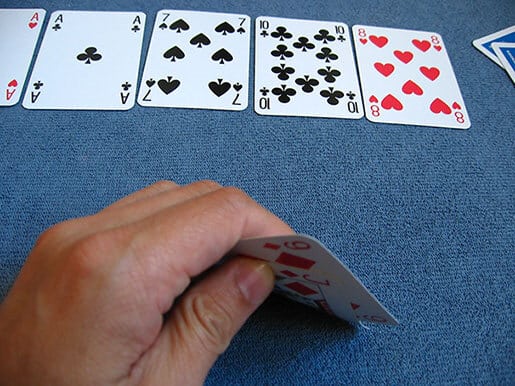Hand rankings are one of the most important fundamental concepts to understand before playing poker. The strength of your hand shapes all your decision-making during the game, which is why it’s so important to know the correct hand rankings depending on your format.
Even if you’re an intermediate poker player who knows the traditional hand rankings, you may not realize they change depending on the variant you’re playing. This guide will discuss the most commonly-used hand rankings in poker, from the Hold’em standard to the two types of lowball rankings.
What are hands?
If you’re really new to poker, you’ll need an explanation of what hands are first. Hands are specific sets of cards that players aim to make. Most hands are made from five cards, but certain forms of poker use less, like Badugi.
Not all hands are equal; there are many different types, each part of an overall hierarchy. The player with the strongest hand in the game’s final round wins, taking the entire pot.

Standard hand rankings
These hand rankings are by far the most-used ones, present in Texas Hold’em, Omaha Poker, Seven Card Stud, and more. Here are the rankings of individual cards, first, from lowest to highest:
2, 3, 4, 5, 6, 7, 8, 9, 10, Jack, Queen, King, Ace. For straights and straight flushes, the ace can function as either a high or low card. If used as a low card, it becomes a “one,” making A-2-3-4-5 the lowest possible straight.
In addition to individual card rankings, particular combinations of cards can increase a hand’s strength. Here they are, from lowest to highest:
High Card – This is a hand without any other combinations. Its value is determined by the highest of the five cards.
Pair – This hand contains two cards of the same rank.
Two Pair – This hand contains two different pairs.
Three-of-a-kind – This hand contains three cards of the same rank.
Straight – This hand contains five cards in consecutive order.
Flush – This hand contains five cards of the same suit.
Full House – This hand contains both a three-of-a-kind and a pair.
Four-of-a-kind – This hand contains four cards of the same rank.
Straight Flush – This hand contains five cards in consecutive order and of the same suit.
Royal Flush – This hand is the highest possible straight flush, consisting of a 10, Jack, Queen, King, and Ace, all of the same suit.
Evaluating poker hands
When judging the strength of a hand, the combination takes precedence over individual hand rankings. Any pair will always beat a high-card hand, any flush will always beat a straight, and so on.
If two cards have the same combination, the value of the combination is determined by individual card rankings. For example, a pair of eights will lose to a pair of aces since aces are ranked higher than eights.
The value of five-card hands like straights and flushes is determined by the highest card of the five. A full house’s value is determined by the three-of-a-kind.
When two hands have the same combination with the same values, the highest extra card will break the tie. For example, 4-4-7-9-10 will beat 4-4-7-8-9 because the former has 10 as the kicker while the latter has nine.

Short deck poker
Short Deck is a rapidly growing poker variant that originated in Asia. It was introduced by Paul Phua and Richard Yong and gained popularity in Asia, eventually reaching the US. It uses a trimmed deck, where all cards below six are cut, leaving a 36-card deck instead of the usual 52.
Short deck hand rankings
Traditional hand rankings had to be readjusted for Short Deck because of the changed probabilities. Flushes now beat full houses since they’re harder to make, with four fewer cards from each suit.
Aces can still be used as low cards, taking the value of a five and making A-6-7-8-9 the lowest possible straight.
One less common rule is the three-of-a-kind beating a straight. This varies depending on where you play, so make sure to find out if you plan on trying Short Deck.
Lowball poker rankings: Ace-to-five
Lowball poker describes an inverted hand ranking system, where the “best” hands, according to traditional rankings, are the worst in lowball, and vice versa. Variations of lowball rankings have become increasingly common, used in games like Razz and Badugi.
There are two primary approaches to lowball: Ace-to-five low and Deuce-to-seven low. The former, also known as California Lowball, is the more popular one. It ignores straights and flushes entirely and considers aces the lowest and “best” cards. Paired hands lose to unpaired ones, three-of-a-kinds lose to paired hands, and so on.
Thus, the best hand in ace-to-five lowball would be A-2-3-4-5 since straights do not matter. Ace-to-five lowball is used in games like Razz, and Hi/Lo games, where the pot is split between the player with the strongest hand and the player with the weakest.
Lowball poker rankings: Deuce-to-seven
Deuce-to-seven, also known as 2-7 Lowball or Kansas Lowball, is the alternative approach to lowball poker. It’s essentially an exact reversal of traditional poker hand rankings. Straights and flushes exist, meaning they are terrible hands you don’t want to make.
Additionally, aces are always considered high, so they are the “worst” cards. This means the best hand in Deuce-to-seven lowball is 2-3-4-5-7 since aces don’t go below twos, and 2-3-4-5-6 would make a straight.
While less widespread, Deuce-to-seven is still used in many popular lowball variants, like 2-7 Triple Draw and Badeucy, a variation of Badugi.

